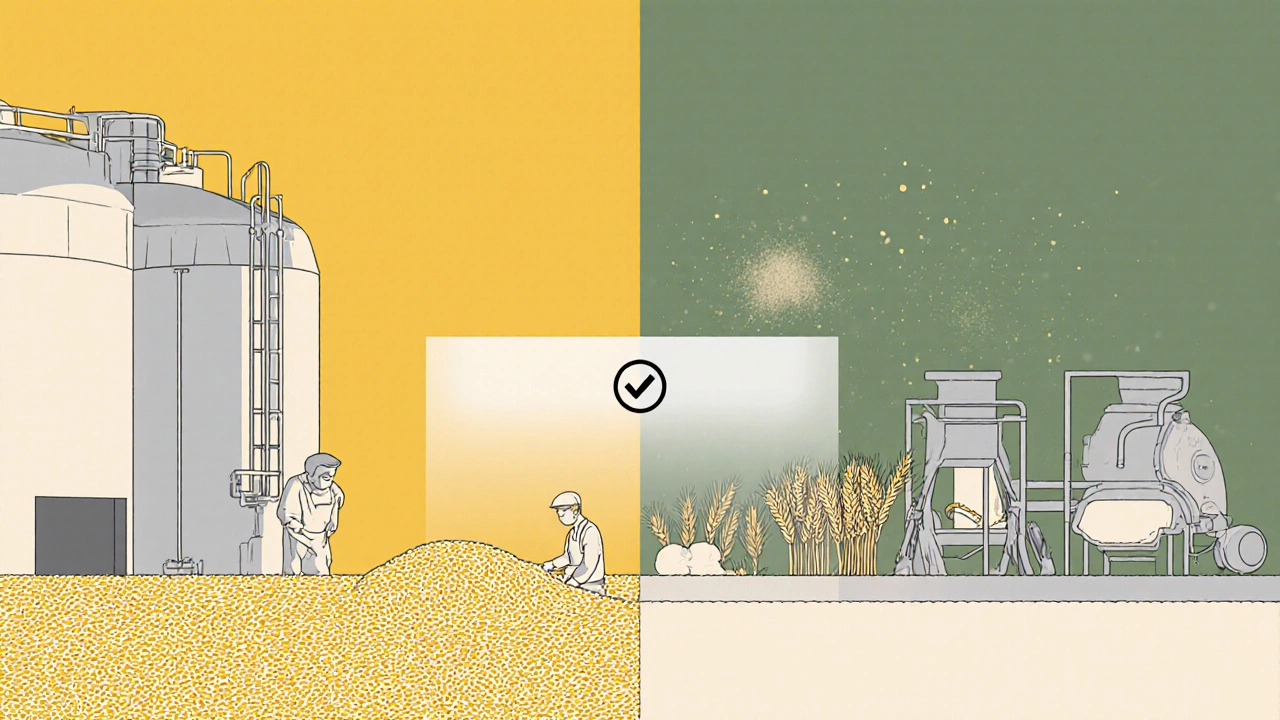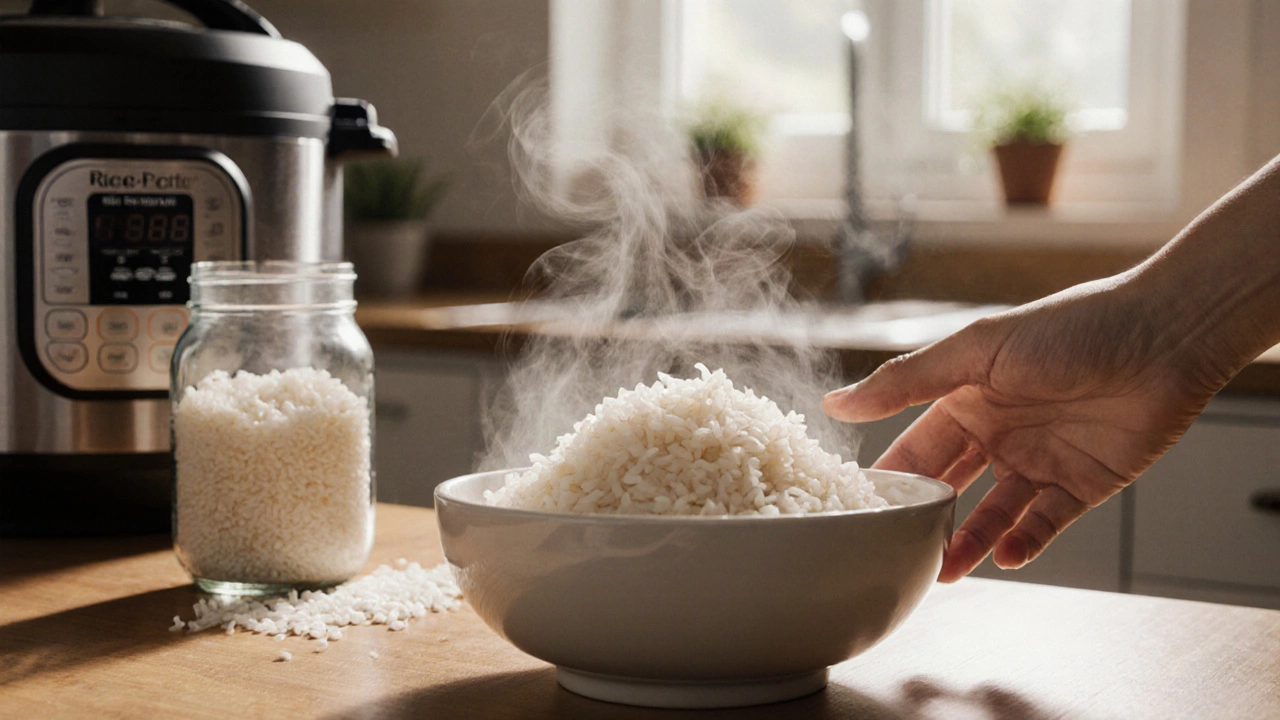Imagine reaching for a bowl of steaming rice and wondering whether it could sabotage your gluten‑free lifestyle. The short answer? gluten-free. But the why and how behind that answer involve a bit of food science, labeling rules, and common misconceptions.
TL;DR
- All plain rice varieties-white, brown, jasmine, basmati, wild-contain no gluten.
- Cross‑contamination can happen if rice is processed with gluten‑containing grains.
- Check the label for "gluten‑free" certification, especially for flavored or pre‑cooked rice mixes.
- People with celiac disease can safely enjoy rice as a staple grain.
- Use separate cookware and storage to avoid accidental gluten exposure.
What Is Rice, Exactly?
Rice is a cereal grain harvested from the grass species Oryza sativa. It feeds more than half the world’s population and comes in dozens of varieties, from fluffy white kernels to nutty brown grains and even the darker, fragrant wild rice (which is actually a different species, Zizania).
The Gluten Factor
Gluten is a protein complex found primarily in wheat, barley, and rye. It gives dough its stretch and helps baked goods hold their shape. Because gluten is a protein, not a carbohydrate or fiber, its presence is determined by the plant species, not by cooking method.
Since rice belongs to the grass family Poaceae but is a completely different genus from wheat, barley, and rye, it naturally lacks the gluten proteins that trigger reactions in celiac disease or gluten sensitivity.
Celiac Disease and the Gluten‑Free Diet
Celiac disease is an autoimmune disorder in which ingestion of gluten damages the small‑intestinal lining. The only medically prescribed treatment is a strict, lifelong gluten‑free diet. This diet eliminates all foods that contain wheat, barley, rye, and their derivatives.
For those with celiac disease, rice is one of the safest grain choices because it is inherently free of the offending proteins.
Why the Confusion Still Exists
Even though rice itself is gluten‑free, several scenarios can turn a plain bowl of rice into a hidden source of gluten:
- Cross‑contamination during processing. If rice is milled, packaged, or stored in facilities that also handle wheat‑based products, tiny gluten particles can mix in.
- Flavored or pre‑cooked mixes. Many convenience packs contain soy sauce, broth, or seasoning blends that use wheat‑based thickeners or malt.
- Restaurant kitchens. Shared sauté pans, steamers, or rice cookers that have previously cooked gluten‑containing foods can leave residue.
Regulatory bodies like the U.S. Food and Drug Administration (FDA) require a product labeled "gluten‑free" to contain less than 20 parts per million (ppm) of gluten. That threshold is regarded as safe for virtually all people with celiac disease.
How to Verify That Your Rice Is Truly Gluten‑Free
Follow this quick checklist before you add rice to your grocery cart:
- Read the label. Look for a "gluten‑free" symbol or statement. If the packaging says "may contain traces of wheat," avoid it.
- Check the ingredient list. Pure rice should list only rice (and maybe water). Any additional seasonings, sauces, or flavorings could introduce gluten.
- Consider the brand. Companies that specialize in gluten‑free foods (e.g., Lundberg, Bob's Red Mill) usually have strict segregation processes.
- Contact the manufacturer. When in doubt, a quick email to the customer service team can clarify whether the product is processed in a dedicated gluten‑free facility.

Cooking Rice Safely at Home
If you already trust the rice you bought, keep the kitchen environment gluten‑free with these simple habits:
- Use dedicated cookware. Have a separate pot, rice cooker, and spoon that never touch wheat‑based dishes.
- Store rice in sealed containers. Avoid bulk bins that might share scoops with gluten‑containing grains.
- Rinse before cooking. A quick rinse under cold water removes dust and any stray particles that could be present.
- Prepare gluten‑free broth. If you like flavored rice, make your own broth with vegetables, herbs, and gluten‑free soy sauce (tamari).
Rice Varieties and Their Gluten‑Free Status
| Rice Type | Gluten Content | Typical Uses |
|---|---|---|
| White long‑grain (e.g., Jasmine) | None | Side dishes, stir‑fries, pilafs |
| Brown long‑grain | None | Health‑focused meals, salads |
| Basmati | None | Indian & Middle‑Eastern cuisine |
| Wild rice | None | Stuffings, grain bowls |
| Arborio (for risotto) | None | Creamy risotto dishes |
| Pre‑flavored rice mixes | Varies - check label | Convenient side dishes |
Every plain rice variety listed above is naturally gluten‑free. The only outlier is the pre‑flavored mix, where added seasonings dictate the gluten status.
Common Myths Debunked
Myth 1: "All grain foods contain gluten." False. Gluten is specific to wheat, barley, and rye. Rice, corn, quinoa, millet, and sorghum are all gluten‑free by nature.
Myth 2: "Brown rice is less safe because it’s less processed." The processing level doesn’t affect gluten content. Brown rice retains the bran layer, which actually adds fiber and nutrients, but still contains zero gluten.
Myth 3: "If a product says ‘contains rice,’ it must be gluten‑free." Not always. Some rice‑based sauces use wheat‑derived thickeners. Always check the full ingredient list.
When to Seek Professional Advice
If you’ve recently been diagnosed with celiac disease or non‑celiac gluten sensitivity, a registered dietitian can help you design a balanced meal plan that includes rice alongside other gluten‑free grains. They can also teach you how to read labels efficiently and avoid hidden gluten sources.
Bottom Line
Rice, in its pure form, is a safe, versatile, and budget‑friendly staple for anyone following a gluten‑free diet. The key is vigilance around processed products and cross‑contamination in shared kitchens. With a few simple habits, you can keep your rice dishes delicious and completely gluten‑free.
Frequently Asked Questions
Can people with celiac disease eat brown rice?
Yes. Brown rice contains no gluten and is safe for celiac patients, provided it hasn’t been contaminated during processing.
Is wild rice truly rice?
Wild rice isn’t a true rice; it’s the seed of an aquatic grass. Nonetheless, it’s naturally gluten‑free and can be used just like other rice varieties.
Do instant rice packets contain gluten?
Plain instant rice is gluten‑free, but flavored versions often include soy sauce, broth powders, or seasonings that may contain wheat. Check the label for a gluten‑free claim.
How can I avoid cross‑contamination at a restaurant?
Ask the staff how they prepare rice. Request a separate pot or a freshly cleaned rice cooker, and specify that you need a gluten‑free preparation.
Is rice flour safe for gluten‑free baking?
Pure rice flour is gluten‑free and works well in combination with other gluten‑free flours (tapioca, almond, etc.) to achieve a good texture in baked goods.

